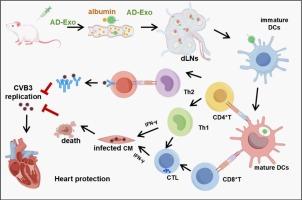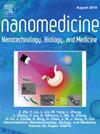Dual-targeting exosome vaccine confers efficient protection against CVB3-induced myocarditis
IF 4.6
2区 医学
Q2 MEDICINE, RESEARCH & EXPERIMENTAL
Nanomedicine : nanotechnology, biology, and medicine
Pub Date : 2025-10-02
DOI:10.1016/j.nano.2025.102865
引用次数: 0
Abstract
Coxsackievirus B3 (CVB3) is a common cause of viral myocarditis, necessitating the development of prophylactic vaccines.. AD-Exo, a dual-targeting exosome vaccine, was developed to induce immune responses via targeting draining lymph nodes (dLNs) and dendritic cells (DCs). By incorporating an albumin-binding domain (ABD) peptide and a DC-guiding peptide (DCpep) into our previous CVB3 exosome vaccine (Exo), the AD-Exo vaccine demonstrated superior immunogenicity. It efficiently bound to mouse serum albumin, amplified antigen enrichment in dLNs, and enhanced DC uptake and maturation. Subcutaneous immunization in mice elicited significantly higher CVB3-specific serum neutralizing IgG with greater affinity than Exo and single-targeting vaccines. It induced robust T cell proliferation and CTL responses, increasing IFN-γ-producing CD4+ and CD8+ T cells. Ultimately, the AD-Exo vaccine reduced cardiac viral load, minimized histopathological damage, and significantly improved survival in challenged mice. This strategy provided novel perspectives for the development of dual-targeting prophylactic vaccines against viral myocarditis.

双靶向外泌体疫苗可有效预防cvb3诱导的心肌炎。
柯萨奇病毒B3 (CVB3)是病毒性心肌炎的常见病因,需要开发预防性疫苗。AD-Exo是一种双靶向外泌体疫苗,通过靶向引流淋巴结(dln)和树突状细胞(dc)诱导免疫应答。通过将白蛋白结合域(ABD)肽和dc引导肽(DCpep)整合到我们之前的CVB3外泌体疫苗(Exo)中,AD-Exo疫苗显示出优越的免疫原性。它能有效地与小鼠血清白蛋白结合,增强dln中抗原的富集,并促进DC的摄取和成熟。小鼠皮下免疫诱导的cvb3特异性血清中和IgG明显高于Exo和单靶向疫苗。它诱导T细胞增殖和CTL反应,增加产生IFN-γ的CD4+和CD8+ T细胞。最终,AD-Exo疫苗降低了心脏病毒载量,减少了组织病理学损伤,并显著提高了小鼠的存活率。这一策略为病毒性心肌炎双靶向预防疫苗的开发提供了新的视角。
本文章由计算机程序翻译,如有差异,请以英文原文为准。
求助全文
约1分钟内获得全文
求助全文
来源期刊
CiteScore
11.10
自引率
0.00%
发文量
133
审稿时长
42 days
期刊介绍:
The mission of Nanomedicine: Nanotechnology, Biology, and Medicine (Nanomedicine: NBM) is to promote the emerging interdisciplinary field of nanomedicine.
Nanomedicine: NBM is an international, peer-reviewed journal presenting novel, significant, and interdisciplinary theoretical and experimental results related to nanoscience and nanotechnology in the life and health sciences. Content includes basic, translational, and clinical research addressing diagnosis, treatment, monitoring, prediction, and prevention of diseases.

 求助内容:
求助内容: 应助结果提醒方式:
应助结果提醒方式:


